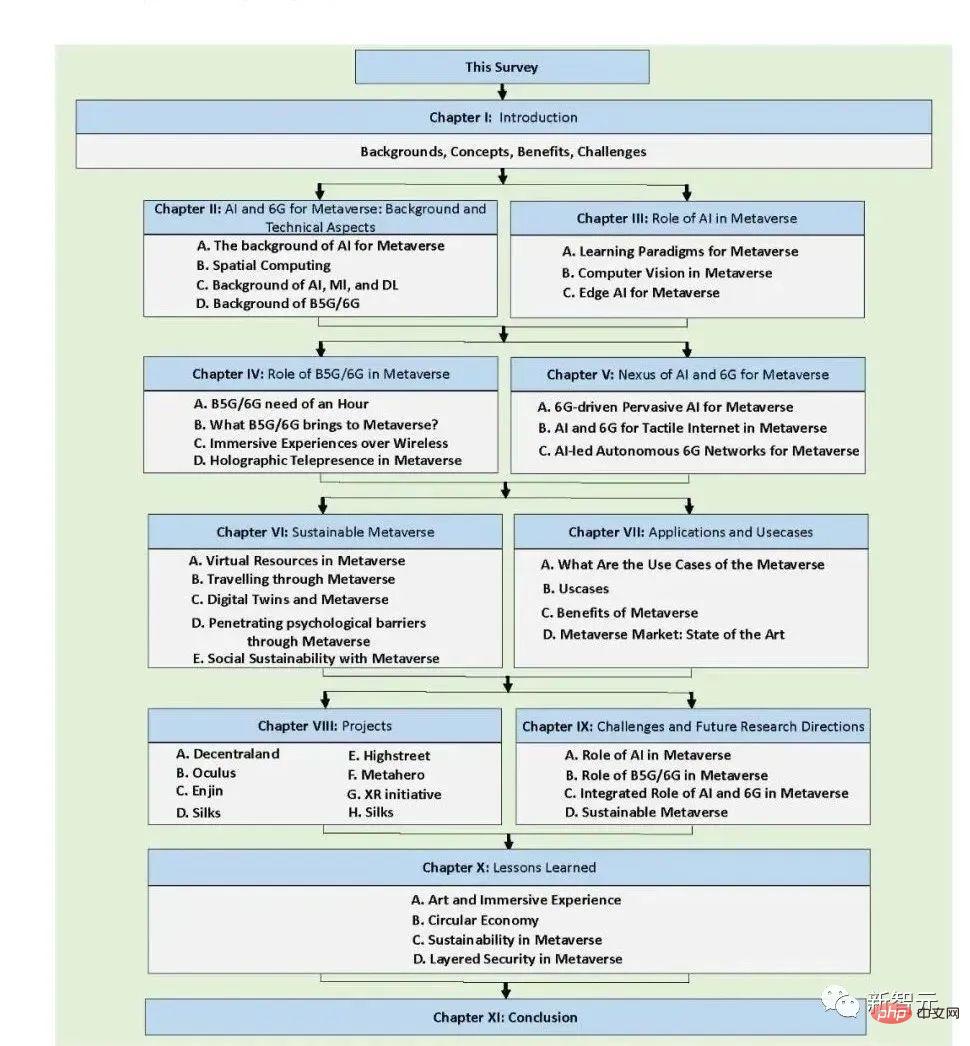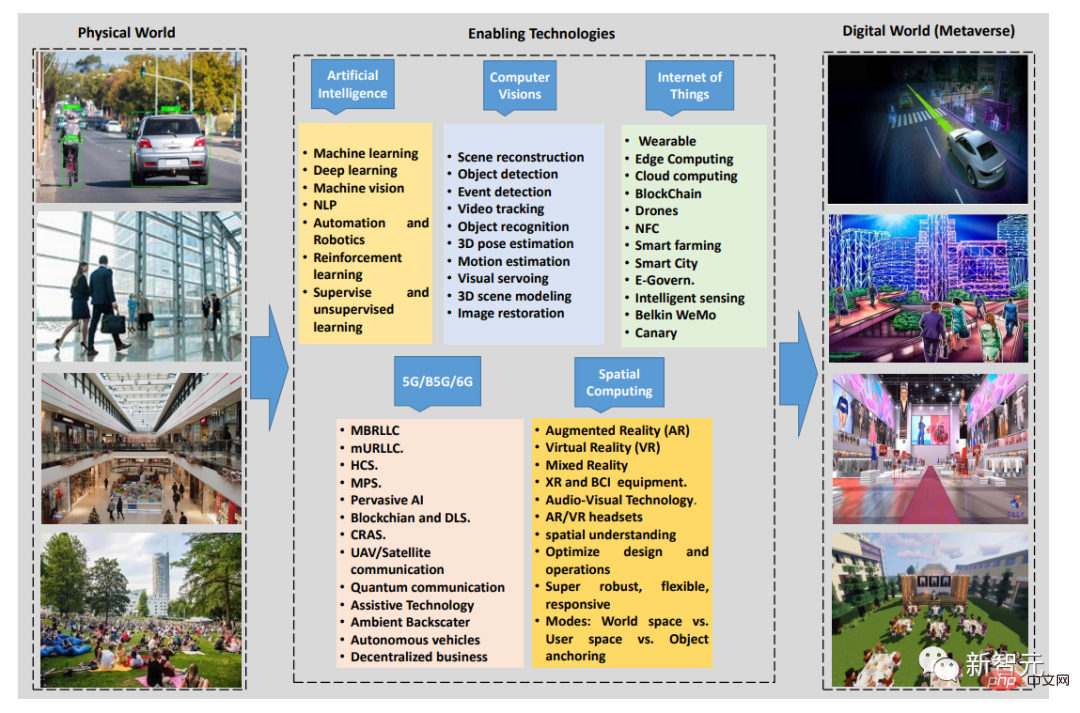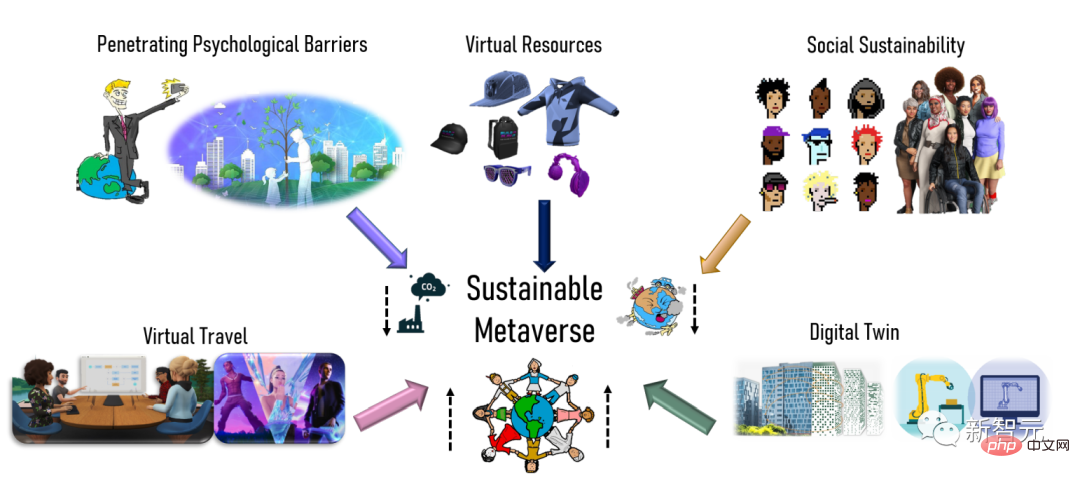 Technology peripherals
Technology peripherals
 AI
AI
 AI, 6G and the Metaverse? Ireland's Donli publishes the latest review of 'Artificial Intelligence, 6G and the Metaverse: Basic Principles, Challenges and Future Research Trends'
AI, 6G and the Metaverse? Ireland's Donli publishes the latest review of 'Artificial Intelligence, 6G and the Metaverse: Basic Principles, Challenges and Future Research Trends'
AI, 6G and the Metaverse? Ireland's Donli publishes the latest review of 'Artificial Intelligence, 6G and the Metaverse: Basic Principles, Challenges and Future Research Trends'
Since Facebook was renamed Meta, a lot of attention, debate, and exploration have intensified about what the Metaverse is, how it works, and possible ways to exploit it.
The Metaverse is expected to be a rapidly emerging continuum of technologies, use cases, capabilities, and experiences that will make up the next evolution of the Internet.
To this end, the South East University of Technology in Ireland provides a comprehensive and in-depth review of AI, 6G and the role of both in realizing the immersive experience of the Metaverse.

Paper address: https://arxiv.org/abs/2208.10921
First of all, the author introduces augmented reality (AR), virtual reality (VR) ), mixed reality (MR) and spatial computing, and then introduces the technical aspects of AI and 6G. The author then investigates the role of AI in the Metaverse by reviewing state-of-the-art technologies in deep learning, computer vision, and edge AI.
Next, the author investigated B5G/6G’s promising services for the Metaverse, and then determined the role of AI in the 6G network, and the role of AI in the 6G network to support Metaverse applications. Finally, the authors describe existing and potential applications, use cases, and projects to highlight the importance of progress in the Metaverse.
Additionally, in order to provide potential research directions to researchers, the authors enumerate the challenges, research gaps, and lessons learned from the literature review of the above technologies.
Introduction
In 2021, the Metaverse begins to impact the real world due to: i) the pandemic lifestyle, and ii) Meta, Amazon, Apple, Netflix and Google (MAANG) for their of users posted features and projects related to the Metaverse.
Since then, the Metaverse has gained absolute attention from academia and industry. At the current point in time, the Metaverse can be generally viewed as a pool of extended reality (XR) space where humans and their digital counterparts interact in a fully immersive manner.
According to a recent survey, most technology experts believe that by 2040, the operation of the Metaverse will be more complete and seamless, and people around the world will be able to fully participate in its fully immersive capabilities , as an integral part of their daily lives.
Essentially, Metaverse is expected to integrate all important aspects of cyberspace or World Wide Web such as B5G/6G, cloud and edge computing, social media, online gaming, augmented reality (AR), virtual reality (VR), cryptocurrency, and artificial intelligence (AI)/machine learning (ML)/deep learning (DL) platforms and applications that allow users to interact virtually.
Some early applications of the Metaverse, such as Roblox, VRChat, Zepeto or Second Life, already allow users to live in "different" or simulated lives, such as making friends and socializing with new virtual characters. These platforms already incorporate AR, VR, and MR as several elements of the Metaverse.
Virtual reality technology uses various software and communication devices such as head-mounted displays (HMDs) to replace the real world around the user with computer-generated digital scenes. In AR, the virtual world and the real world are seamlessly connected to create new interactive experiences. Finally, MR emerged as a combination of AR and VR and their underlying technologies.
It is worth noting that the popularity of these technologies has made AR and VR devices popular at reasonable prices, while continuously improving the quality of user experience (QoE).
However, in order to achieve the processing power and communication speed required for VR services to provide a smooth and immersive experience, most HMDs still require users to connect to a PC or game console. The only device that can escape this shackles is Meta's Oculus Quest. Over the next few years, there will be many improvements in visual content and connection-free experiences on mobile devices as processors become faster and wireless communication technologies become latency-free.
Especially with the presence of 5G, the number of devices connected to the network will proliferate, which will have a profound impact on the growth of the Metaverse. 5G enables real-time communication and information exchange between all connected devices with low latency.
Obviously, 5G offers faster speeds than 4G, but most importantly, it offers a variety of other benefits beyond speed. Specifically, Metaverse developers will be able to benefit from 5G’s low latency by creating applications that stream 360° content in near real-time.
The Metaverse will also promote the development trend of human-centered/data-centered intelligent systems. This trend has placed many limitations on existing 5G communication systems, making them less efficient and unreliable.
For example, considering the 0.1ms latency requirement of haptic-based metaverse applications such as teleportation or teleoperation, 5G can only provide an air interface latency of less than 1ms, which is insignificant for such applications .
Additionally, according to Cisco, mobile data traffic has grown 17 times in the past 5 years and is expected to continue to grow. In particular, 5G traffic will account for 12% of total global mobile traffic by 2022.
5G networks are designed to cover a wide range of spectrum, such as millimeter wave (up to 300 GHz), and therefore can handle large amounts of wireless traffic.
Since the Metaverse will bring some applications that may require data rates higher than Tbps, this is unlikely to be the case with mmWave systems, such as Holographic Presence (HT), Tactile Sensory Communication, Brain-Computer Interface (BCI) ) and XR. Therefore, to achieve the goal of Tbps data rates, researchers began to explore the terahertz (THz) frequency band (0.1-10 THz).
The 6G communication system is expected to provide a data rate of 1Tbps and operate at a bandwidth of 3Thz to support data-intensive applications such as online games, high-definition video live broadcast, holographic content transmission, and real-time avatar interaction. 6G will also provide ubiquitous coverage and ultra-low latency (less than 1ms), and support mobility capabilities of approximately 100 km/h by integrating space, air, ground, and ocean networks.
However, metaverse applications such as virtual education and training, precise navigation and positioning, immersive games and telemedicine applications will all be realized through AI and 6G, making the metaverse even more successful. In particular, cutting-edge techniques in computer vision can be used to provide three-dimensional animated human models or realistic animated faces, or even to create holograms.
However, a key challenge in bringing 3D content to Metaverse services is the scalability of existing infrastructure. The rise of the Metaverse therefore makes it critical to develop critical tools and infrastructure that enable Metaverse developers to build better and more scalable 3D/AR/VR experiences regardless of platform or purpose.
In principle, researchers need to take a step away from the supervised learning paradigm of artificial intelligence and adopt diverse learning strategies such as reinforcement learning and self-supervised learning in order to scale in the metaverse environment. In addition, the edge computing capabilities of 6G networks can be combined with AI to provide edge intelligence, thereby reducing network latency and privacy issues with enhanced QoE in the metaverse.
Driven by existing technologies and foreseeable challenges, the authors survey the state-of-the-art technologies of AI and 6G in the context of the metaworld to answer the following questions: How to leverage AI, 6G and the in between Continuous progress to provide a better and sustainable metaworld experience?
It is clear from the above discussion that some of the existing research focuses on a very narrow perspective of AI, 6G and related technologies, while others investigate the social, economic and digital value of the Metaverse. effect. In contrast, in this review, the authors provide the following key contributions:
- The authors describe the underlying components of the Metaverse, namely VR, MR, AR, and spatial computing. This article provides a detailed background on the above mentioned technologies so that readers can understand the technical aspects and state-of-the-art techniques to enable a fully immersive metaverse.
- The author provides an extensive review of the state-of-the-art technology of artificial intelligence and examines the role of artificial intelligence in realizing the metaverse. Essentially, the authors define the role of artificial intelligence in the layered architecture of the Metaverse, followed by state-of-the-art techniques for computer vision applications, learning paradigms, and edge AI for the Metaverse.
- The author explains the role of B5G/6G in realizing the metaverse by first answering the following key questions: i) Does B5G/6G take an hour? ii) What services can B5G/6G bring to the metaverse? Next, the authors review the latest technologies for immersive experiences and wireless holographic telepresence by specifically considering 5G-NR, URLLC, mmWave, MEC, thzcomm and their interactions.
- The author also considers the combined role of AI and 6G in realizing the metaverse. In principle, the authors investigate the potential of AI for 6G networks and 6G networks for AI-enabled metaverses. Next, the authors will investigate the sustainability of the Metaverse within the previously mentioned technological context, followed by potential applications and use cases as well as ongoing projects. Finally, the authors present challenges and future research directions as well as lessons learned from this investigation.

The term "Metaverse" is a combination of the prefix "meta" (meaning "beyond") and the suffix "verse" (abbreviation of "universe"). Therefore, it refers to the universe beyond the physical world. This "transcendent universe" alludes to a computer-generated environment rather than a metaphysical or mystical conceptual realm beyond physical reality.
The Metaverse is a fully immersive three-dimensional digital environment, unlike cyberspace, which refers to all online spaces.

The metaverse refers to the transformation of physical reality into the digital realm, so it can be a mixture of physical reality and the digital realm, such as AR, VR, MR.

Sustainable Metaverse
Reference: https://arxiv.org/abs/2208.10921
The above is the detailed content of AI, 6G and the Metaverse? Ireland's Donli publishes the latest review of 'Artificial Intelligence, 6G and the Metaverse: Basic Principles, Challenges and Future Research Trends'. For more information, please follow other related articles on the PHP Chinese website!

Hot AI Tools

Undresser.AI Undress
AI-powered app for creating realistic nude photos

AI Clothes Remover
Online AI tool for removing clothes from photos.

Undress AI Tool
Undress images for free

Clothoff.io
AI clothes remover

Video Face Swap
Swap faces in any video effortlessly with our completely free AI face swap tool!

Hot Article

Hot Tools

Notepad++7.3.1
Easy-to-use and free code editor

SublimeText3 Chinese version
Chinese version, very easy to use

Zend Studio 13.0.1
Powerful PHP integrated development environment

Dreamweaver CS6
Visual web development tools

SublimeText3 Mac version
God-level code editing software (SublimeText3)

Hot Topics
 WorldCoin (WLD) price forecast 2025-2031: Will WLD reach USD 4 by 2031?
Apr 21, 2025 pm 02:42 PM
WorldCoin (WLD) price forecast 2025-2031: Will WLD reach USD 4 by 2031?
Apr 21, 2025 pm 02:42 PM
WorldCoin (WLD) stands out in the cryptocurrency market with its unique biometric verification and privacy protection mechanisms, attracting the attention of many investors. WLD has performed outstandingly among altcoins with its innovative technologies, especially in combination with OpenAI artificial intelligence technology. But how will the digital assets behave in the next few years? Let's predict the future price of WLD together. The 2025 WLD price forecast is expected to achieve significant growth in WLD in 2025. Market analysis shows that the average WLD price may reach $1.31, with a maximum of $1.36. However, in a bear market, the price may fall to around $0.55. This growth expectation is mainly due to WorldCoin2.
 What does cross-chain transaction mean? What are the cross-chain transactions?
Apr 21, 2025 pm 11:39 PM
What does cross-chain transaction mean? What are the cross-chain transactions?
Apr 21, 2025 pm 11:39 PM
Exchanges that support cross-chain transactions: 1. Binance, 2. Uniswap, 3. SushiSwap, 4. Curve Finance, 5. Thorchain, 6. 1inch Exchange, 7. DLN Trade, these platforms support multi-chain asset transactions through various technologies.
 What are the hybrid blockchain trading platforms?
Apr 21, 2025 pm 11:36 PM
What are the hybrid blockchain trading platforms?
Apr 21, 2025 pm 11:36 PM
Suggestions for choosing a cryptocurrency exchange: 1. For liquidity requirements, priority is Binance, Gate.io or OKX, because of its order depth and strong volatility resistance. 2. Compliance and security, Coinbase, Kraken and Gemini have strict regulatory endorsement. 3. Innovative functions, KuCoin's soft staking and Bybit's derivative design are suitable for advanced users.
 How to win KERNEL airdrop rewards on Binance Full process strategy
Apr 21, 2025 pm 01:03 PM
How to win KERNEL airdrop rewards on Binance Full process strategy
Apr 21, 2025 pm 01:03 PM
In the bustling world of cryptocurrencies, new opportunities always emerge. At present, KernelDAO (KERNEL) airdrop activity is attracting much attention and attracting the attention of many investors. So, what is the origin of this project? What benefits can BNB Holder get from it? Don't worry, the following will reveal it one by one for you.
 Aavenomics is a recommendation to modify the AAVE protocol token and introduce token repurchase, which has reached the quorum number of people.
Apr 21, 2025 pm 06:24 PM
Aavenomics is a recommendation to modify the AAVE protocol token and introduce token repurchase, which has reached the quorum number of people.
Apr 21, 2025 pm 06:24 PM
Aavenomics is a proposal to modify the AAVE protocol token and introduce token repos, which has implemented a quorum for AAVEDAO. Marc Zeller, founder of the AAVE Project Chain (ACI), announced this on X, noting that it marks a new era for the agreement. Marc Zeller, founder of the AAVE Chain Initiative (ACI), announced on X that the Aavenomics proposal includes modifying the AAVE protocol token and introducing token repos, has achieved a quorum for AAVEDAO. According to Zeller, this marks a new era for the agreement. AaveDao members voted overwhelmingly to support the proposal, which was 100 per week on Wednesday
 What is the analysis chart of Bitcoin finished product structure? How to draw?
Apr 21, 2025 pm 07:42 PM
What is the analysis chart of Bitcoin finished product structure? How to draw?
Apr 21, 2025 pm 07:42 PM
The steps to draw a Bitcoin structure analysis chart include: 1. Determine the purpose and audience of the drawing, 2. Select the right tool, 3. Design the framework and fill in the core components, 4. Refer to the existing template. Complete steps ensure that the chart is accurate and easy to understand.
 The top ten free platform recommendations for real-time data on currency circle markets are released
Apr 22, 2025 am 08:12 AM
The top ten free platform recommendations for real-time data on currency circle markets are released
Apr 22, 2025 am 08:12 AM
Cryptocurrency data platforms suitable for beginners include CoinMarketCap and non-small trumpet. 1. CoinMarketCap provides global real-time price, market value, and trading volume rankings for novice and basic analysis needs. 2. The non-small quotation provides a Chinese-friendly interface, suitable for Chinese users to quickly screen low-risk potential projects.
 Ranking of leveraged exchanges in the currency circle The latest recommendations of the top ten leveraged exchanges in the currency circle
Apr 21, 2025 pm 11:24 PM
Ranking of leveraged exchanges in the currency circle The latest recommendations of the top ten leveraged exchanges in the currency circle
Apr 21, 2025 pm 11:24 PM
The platforms that have outstanding performance in leveraged trading, security and user experience in 2025 are: 1. OKX, suitable for high-frequency traders, providing up to 100 times leverage; 2. Binance, suitable for multi-currency traders around the world, providing 125 times high leverage; 3. Gate.io, suitable for professional derivatives players, providing 100 times leverage; 4. Bitget, suitable for novices and social traders, providing up to 100 times leverage; 5. Kraken, suitable for steady investors, providing 5 times leverage; 6. Bybit, suitable for altcoin explorers, providing 20 times leverage; 7. KuCoin, suitable for low-cost traders, providing 10 times leverage; 8. Bitfinex, suitable for senior play





